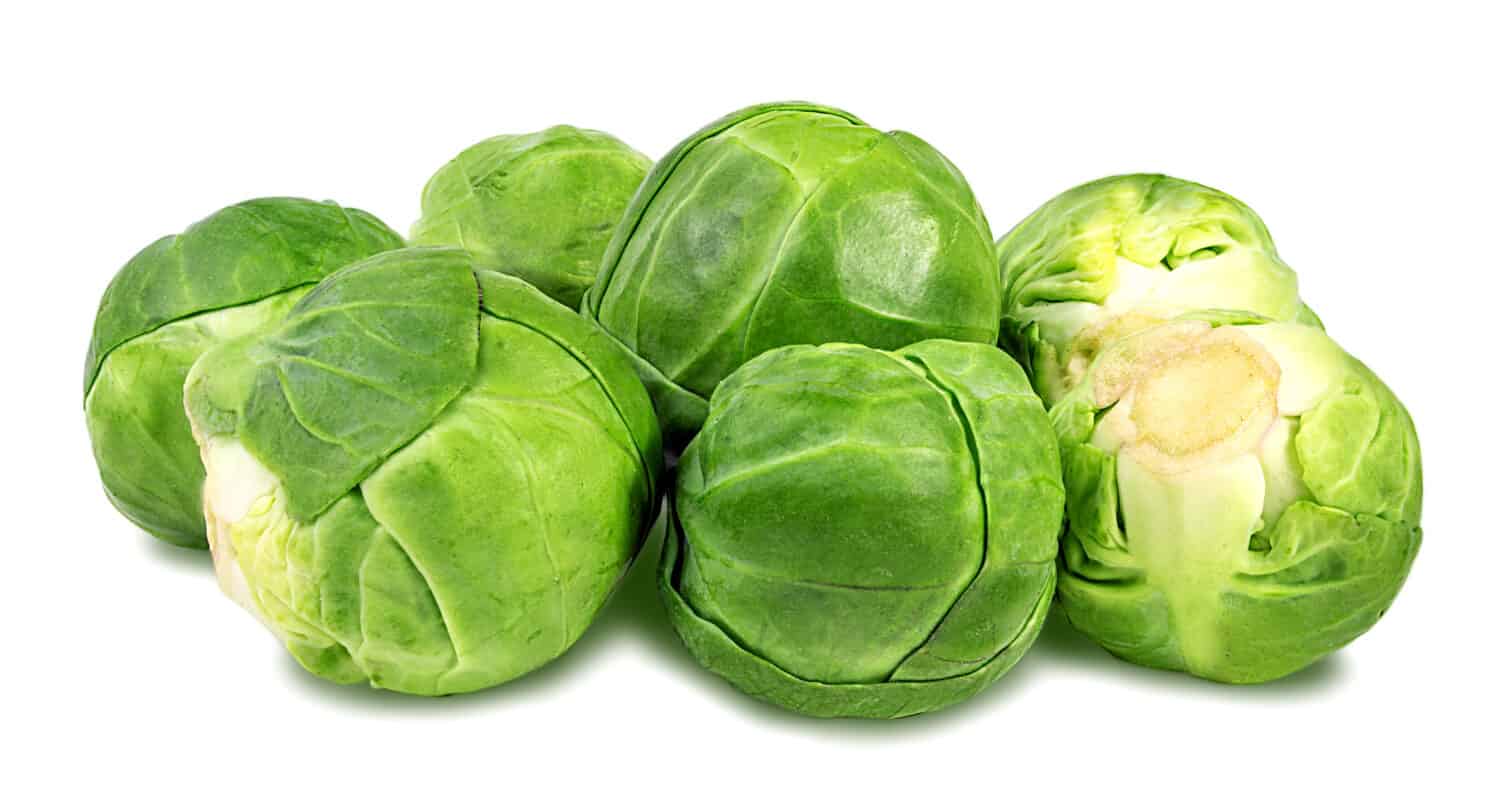Growing Brussels sprouts can be straightforward and simple. To ensure that the sprouts are ready for harvest in the fall or winter, plant seedlings at the beginning of summer. This guide will teach you how to grow Brussels sprouts like an expert. Now you can harvest and eat Brussels sprouts during their peak season.
Peak Brussels Sprouts Season
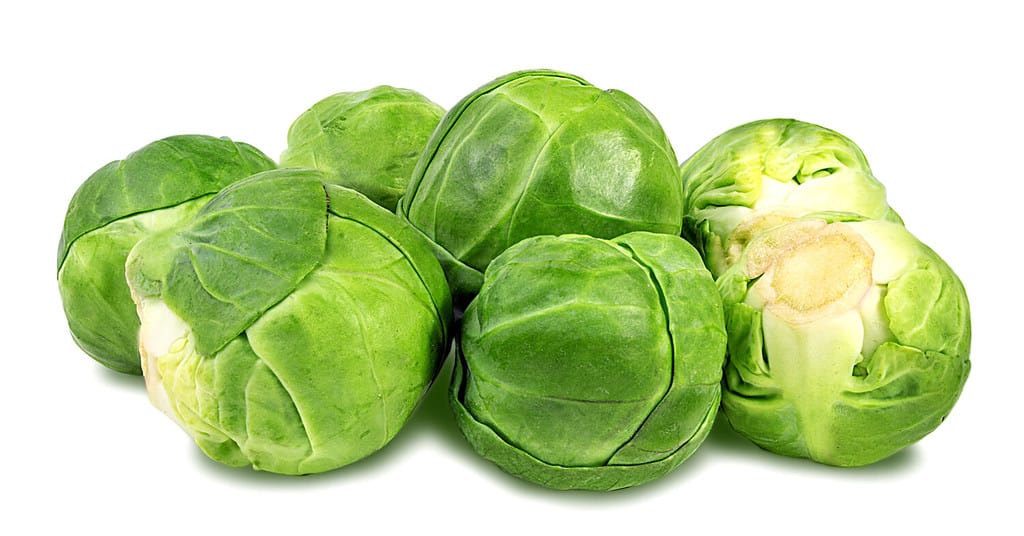
Brussels sprouts are a cool season crop with a peak season in fall and winter.
©Chatham172/Shutterstock.com
Brussels sprouts are a beloved member of the Cole family. They thrive when planted during the summer months and are typically ready for harvest in the crisp days of autumn. As temperatures cool down and daylight hours shorten, these miniature cabbage-like vegetables develop their signature flavor and texture that make them so sought after by food enthusiasts.
The peak Brussels sprouts season spans from October to December. This season provides an abundance of these delectable greens to grace our plates during festive gatherings and cozy holiday meals. During this time, farmers across various regions diligently cultivate their Brussels sprout crops to ensure optimal quality and taste.
However, it is worth noting that in certain areas blessed with milder climates or suitable growing conditions, the Brussels sprouts season can extend well into March. This extended duration allows both growers and consumers alike to relish in the delightfully nutty flavor profile of fresh Brussels sprouts for several more months beyond their traditional peak period.
Where do Brussels Sprouts Grow?
In the US, California is the main hub for commercially grown Brussels sprouts. There, extensive cultivation takes place from fall through winter. However, these delectable miniature cabbages can flourish in a home garden across USDA Hardiness zones 3-9. The key to their successful growth lies in timing. Avoiding the scorching heat of summer and instead allowing them to mature during the refreshing autumn and winter seasons. By adhering to this optimal scheduling, gardeners are generously rewarded with an abundant harvest. So whether you’re enjoying them fresh off Californian farms or nurturing them yourself at home, embrace these versatile vegetables during their peak season for an unmatched culinary experience.
Indoor Prep
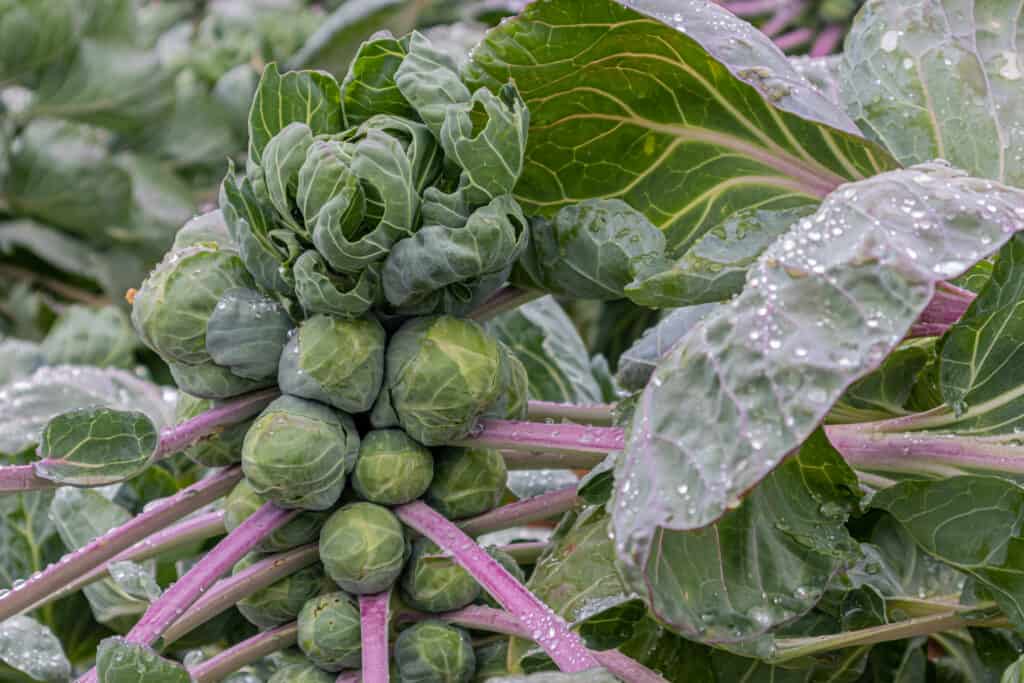
If you have an excessive amount of Brussels sprouts during the peak season, you can freeze them.
©mm7/Shutterstock.com
When it comes to growing Brussels sprouts, transplanting the plants is often recommended for achieving better results compared to direct seeding. Regardless of the method chosen, proper soil preparation weeks before planting seeds is crucial for successful growth. If you opt for starting from seeds, May or early June are ideal months for sowing them. However, it’s worth noting that these delicate seedlings should be transplanted into the garden between late June and early July.
Ensure enough space and optimal conditions for each plant’s development. Plant Brussels sprouts seedlings approximately 15 to 18 inches apart from one another. This spacing allows ample room for their leaves and stalks to expand without overcrowding. Additionally, rows should be set at a distance of 36 inches apart. This spacing will facilitate easy access during maintenance tasks and harvesting.
By following these indoor preparation guidelines carefully, you can enhance your chances of cultivating thriving Brussels sprout plants that yield a bountiful harvest when they reach their peak season.
Seeding Outdoors
When it comes to growing Brussels sprouts from direct seeds, keep in mind that they require a bit more time compared to using transplants. To ensure successful development, you’ll need to calculate approximately four months back from your local average frost date in the autumn. This will help you determine the ideal timing for planting so that your Brussels sprouts can thrive during cooler months.
To begin the seeding process, place three seeds together about a quarter inch deep into the soil. It’s crucial to provide enough space for each plant to grow and flourish. So, make sure there is an 18-inch gap between each grouping of seeds. As the seedlings start establishing themselves and showing signs of growth, you’ll need to thin them out by removing all but one seedling per 18 inches.
This careful thinning process ensures that only the strongest and healthiest plants remain. It also allows ample room for their roots and foliage to develop fully. By giving your Brussels sprout plants sufficient space at this early stage, you are setting them up for optimal growth and productivity as they mature.
Remember, timing is key when it comes to cultivating these delectable vegetables outdoors. Consider factors such as local climate patterns and expected frost dates in order to plan ahead effectively. With proper care and attention throughout their growth journey, your Brussels sprouts can yield a bountiful harvest of tender buds during those delightful cooler seasons when they truly shine on our plates.
Water, Soil, and Light
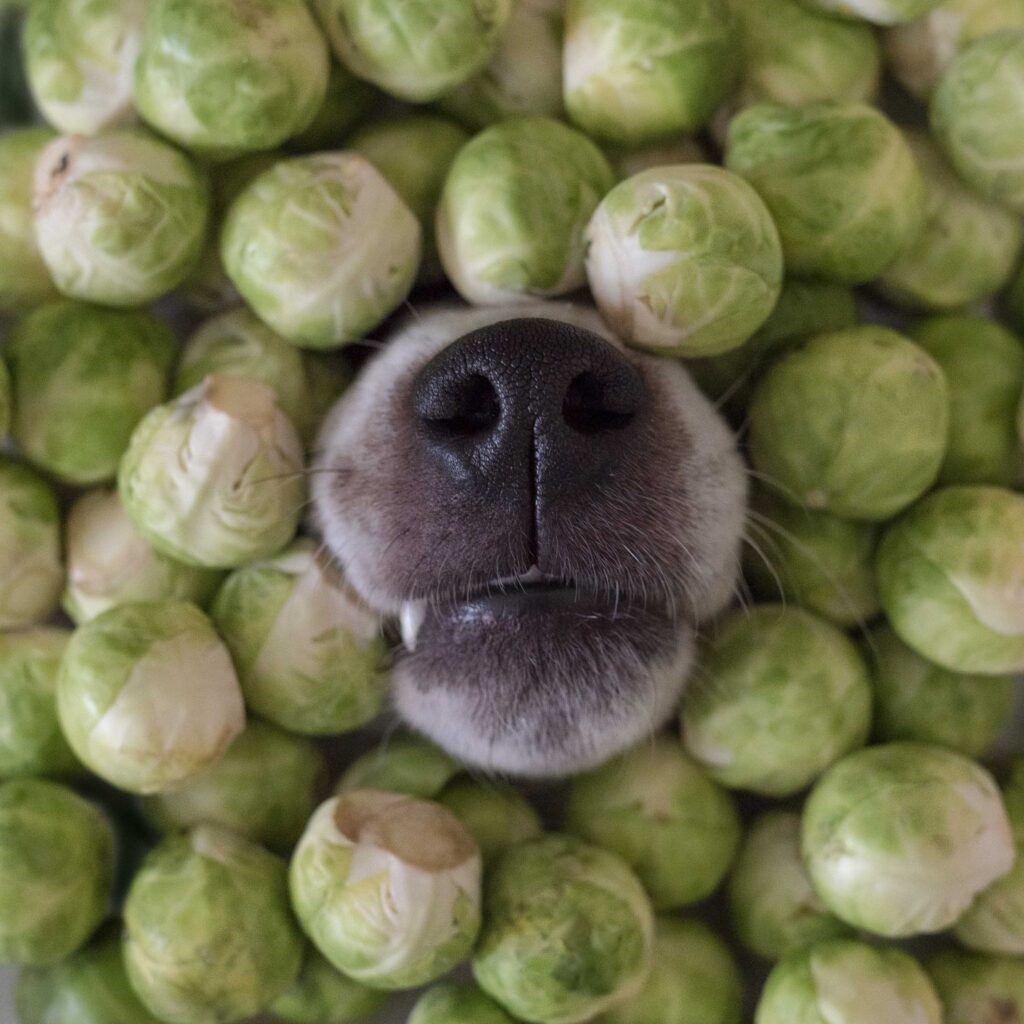
Don’t worry. You can share your Brussels sprouts with your dog in moderation.
©Irina Filkova/Shutterstock.com
In order for Brussels sprouts to thrive and produce the most optimal crop, it is essential to provide them with adequate water and create a suitable growing environment. These plants require at least an inch of water per week. Water more during the scorching summer heat when they are particularly susceptible to stress. By ensuring sufficient hydration, gardeners can promote healthy growth and robust yields.
Another crucial factor in cultivating successful Brussels sprouts lies in the quality of the soil. It is recommended to cultivate these vegetables in well-drained and fertile soil. Soil that possesses a slightly acidic pH ranging from 6.2 to 6.8 is best. To enhance the soil’s fertility, incorporate compost or other organic matter. Mix leaves or grass clippings into the planting bed several weeks prior to sowing. This can greatly benefit their development. This practice enriches the soil with vital nutrients while improving its texture, thus providing an ideal foundation for strong root systems and vigorous plant growth.
When it comes to light requirements, Brussels sprouts exhibit a preference for full sun exposure. However, they do possess slight tolerance towards shade conditions as well. Therefore, placing them in locations that receive ample sunlight throughout the day will optimize their overall productivity and yield potential.
By taking into account these essential elements — regular watering schedules, fertile soil enriched with organic matter, and proper sun exposure — growers can ensure that their Brussels sprouts flourish within peak season conditions while maximizing both the quality and quantity of harvests.
Fertilizer

Compost is rich in nitrogen to fertilize your Brussels sprouts.
©Singkham/Shutterstock.com
In order to ensure optimal growth and sprout production, it is essential for Brussels sprouts to receive an adequate supply of nutrients from the soil. While adding compost prior to planting can often provide sufficient nourishment for the duration of the growing season, there may be instances where additional compost becomes necessary if growth starts to slow down.
One key nutrient that Brussels sprouts heavily rely on is nitrogen. It plays a crucial role in promoting robust sprout development. Compost serves as a natural source of this vital element, making it an ideal option for enhancing nitrogen levels in the soil. By incorporating more compost around the plants when needed, gardeners can effectively boost nitrogen content and support healthy growth.
Another important micronutrient required by Brussels sprouts is boron. Although certain fertilizers contain traces of boron, there exists a simple method for introducing this micronutrient into your garden. Mixing one tablespoon of borax with five quarts of water creates a solution that can be evenly sprinkled over approximately 10 square feet of ground per quart. This easy technique ensures that your Brussels sprouts benefit from ample amounts of boron, further contributing to their overall quality and yield.
By diligently providing these essential nutrients through proper fertilizer application techniques and using compost as a natural source of nitrogen, you are empowering your Brussels sprouts plants with everything they need to thrive during their peak season.
Brussels Sprouts Care

The stalks of Brussels sprouts grow about three feet tall and need regular trimming.
©Anton Havelaar/Shutterstock.com
Brussels sprouts plants, known for their compact and leafy appearance, have the potential to reach impressive heights of up to three feet or 36 inches tall. To ensure optimal growth and stability, it is advisable to provide support in the form of stakes as they mature. These sturdy structures enable the plants to withstand strong winds or heavy rain that may otherwise cause them to bend or break.
In order to enhance photosynthesis and promote healthy development, it is essential to take good care of the foliage. Regularly inspecting the plant for yellow leaves, particularly those situated at the bottom section, is crucial. Removing these yellowing leaves not only improves aesthetics but also facilitates maximum sunlight penetration toward the lower parts of the stalks.
By strategically eliminating any decaying or discolored foliage, gardeners can create an ideal environment for Brussels sprout plants’ growth. This practice allows vital nutrients from sunlight and air circulation access throughout all levels of the plant’s structure. Ultimately, this meticulous care contributes significantly towards fostering robust and thriving Brussels sprout crops during their peak season.
How to Harvest Brussels Sprouts
Brussels sprouts need a long growing period before they can be harvested. To do this, pick the sprouts when they are firm and about an inch or two in size. To get a larger yield, cut off the top (called the terminal bud) of the plant when the lowest sprouts reach an inch in diameter. For tastier sprouts, harvest them after a frost. These crops can also be stored for up to five weeks at 36 degrees Fahrenheit after removing the leaves from the stalk.
How to Use Brussels Sprouts
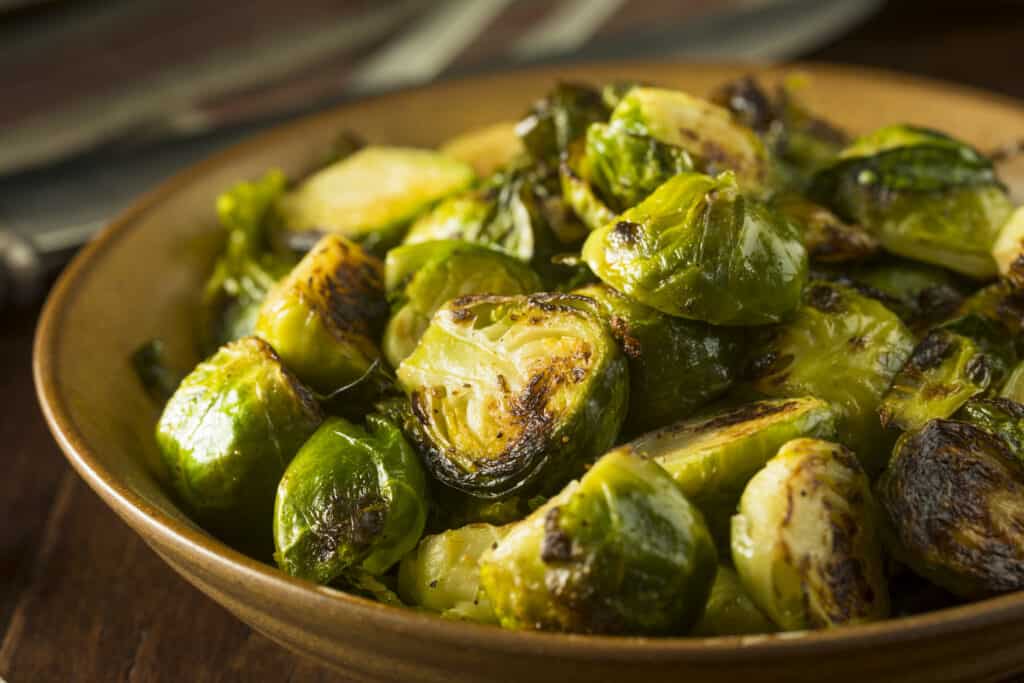
Brussels sprouts are delicious, either roasted, steamed, or air-fried.
©Brent Hofacker/Shutterstock.com
During peak season, when Brussels sprouts are abundant and at their freshest, there are endless possibilities for preparing these delectable mini-cabbages. Here are three of our favorite ways to elevate your Brussels sprout game:
Roasted Brussels Sprouts with Balsamic Glaze
One classic yet irresistible way to enjoy this veggie is by roasting them until they turn golden brown and crispy on the outside while retaining a tender interior. Tossed in olive oil, salt, and pepper, these roasted beauties can be taken up a notch with a tangy balsamic glaze drizzled generously over them just before serving. The sweet and acidic notes of the glaze perfectly complement the earthy flavors of the Brussels sprouts.
Shredded Brussels Sprout Salad with Lemon Vinaigrette
For those looking for a lighter option bursting with freshness, consider making a vibrant shredded Brussels sprout salad. Thinly slice or shred raw Brussels sprouts using a mandoline or sharp knife and combine them with other complementary ingredients such as tart apple slices, dried cranberries for sweetness, toasted almonds for crunchiness, and crumbled cheese like feta or goat cheese for creaminess. Toss it all together in a zesty lemon vinaigrette dressing that enhances the flavors while adding brightness to every bite.
Sautéed Garlic Parmesan Brussels Sprouts
If you’re seeking sheer indulgence without compromising on taste or simplicity, sautéing Brussels sprouts with garlic and parmesan is a delightful way to elevate this humble vegetable. To make this delicious meal, start by removing any additional outer leaves from the Brussels sprouts and cutting them in half. Then, heat a pan over medium heat with some olive oil or butter. Once it’s hot, throw in some garlic cloves for a fragrant taste. Place the Brussels sprouts halves cut-side down in the skillet to allow them to caramelize. Let them cook for a few minutes until they turn golden brown. Flip them over carefully using tongs or a spatula, and be sure not to overcrowd the pan. Once both sides have the desired caramelization, sprinkle some grated Parmesan cheese over them and let the residual heat melt the cheese.
How to Store Brussels Sprouts
When it comes to storing Brussels sprouts, there are a few key steps you can take to ensure their freshness and flavor are preserved for as long as possible. First and foremost, it is crucial to keep the sprouts in a cool environment. Ideally, store them in the refrigerator’s crisper drawer or an unsealed plastic bag.
Before storing Brussels sprouts, remove any loose leaves or damaged outer layers. These outer leaves tend to wilt faster and can affect the overall quality of the vegetable. Gently peel off these undesirable leaves until you reach the firmer ones beneath.
To maintain optimal freshness, avoid washing Brussels sprouts before storage since moisture promotes spoilage. Instead, wait until just before cooking or consuming them to give them a thorough rinse under cold water.
If you have harvested your own homegrown Brussels sprouts or purchased them with their stalk intact, leaving them attached can help prolong their shelf life. Storing the entire stalk in a container filled partially with water will provide hydration and preserve their crispness for several days.
For those who prefer pre-trimmed Brussels sprouts commonly found at grocery stores, transferring them into a perforated plastic bag or loosely wrapping them in damp paper towels helps maintain humidity levels without causing excessive moisture buildup that could lead to rotting.
You can also freeze excess Brussels sprouts during their peak season. Blanch them first and then lay them on a cookie sheet to freeze. After frozen, pack them tightly into an airtight freezer bag.
Thank you for reading! Have some feedback for us? Contact the AZ Animals editorial team.

